How Much Weed Does One Plant Produce?
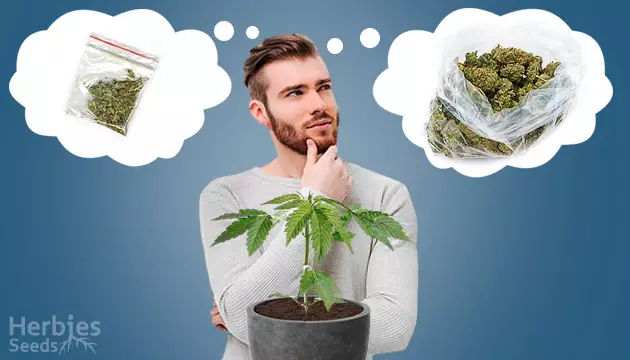
There are two main goals for every cannabis grower. Obviously, they need to grow quality plants. However, they also need to grow large in terms of weight. But how much weed does one plant produce? That’s something of a loaded question. In fact, there are numerous variables that can affect how much weed a grower can harvest per plant.
Cannabis Yield: What’s On The Scale?
How much weed can you get from one plant is a question with many answers, simply because there are too many factors playing their role in marijuana plant yields. Before we expand on them, we’re going to give you some numbers for a rough idea of your future harvest. However, take them with a grain of salt – you’ll learn why later.
You can expect:
- an average of ~5-9oz (150-250g) in a 3,5 x 1,5 x 6,5ft (1 x 0,5 x 2m) grow box under 250W HPS lights
- an average of ~9-14oz (250-400g) in a 3,5 x 1,5 x 6,5ft (1 x 0,5 x 2m) grow box under 400W HPS lights
- an average of ~10-21oz (300-600g) in a 4 x 4 x 8ft (1,2 x 1,2 x 2,5m) grow box under 600W HPS lights
- an average of ~18-36oz (500-1000g) in a 5 x 5 x 8ft (1,5 x 1,5 x 2,5m) grow box under 1000W lights
Note that the upper limit that we’ve provided as the marijuana yield per plant can be achieved in nearly perfect conditions, with the right genetics, in the hands of an experienced grower. Newbies should look at the lower limit when planning the average pot plant yield for their future grow. That said, cannabis plants are often unpredictable, so even beginner growers may be pleasantly surprised with their weed plant yield.
Factors Impacting Yield: The Break-Down
There’s no general rule on how much any given marijuana plant can yield. The amount of weed that an indoor grower in a Colorado warehouse gets per plant will never be the same as an outdoor grower in the northern California sun. In fact, these growers can even grow the exact same strains of marijuana and see completely different results in how much weed they get per plant. Several factors can affect plant yields – and not all of them are positive. However, if you can identify these factors, it can lead to a better understanding of how they affect the total weight of a marijuana plant. Seasoned growers know how to use these variables to grow massive buds.
If a grower doesn’t maintain steady control of some of the most crucial variables in growing cannabis, they’re going to have a difficult time maintaining high-yielding harvests. If your harvests don’t bear enough weight, you may actually end up losing money paying for expenses like lighting, nutrients and growing tools that you might have used incorrectly.
Growing Indoors Vs. Outdoors
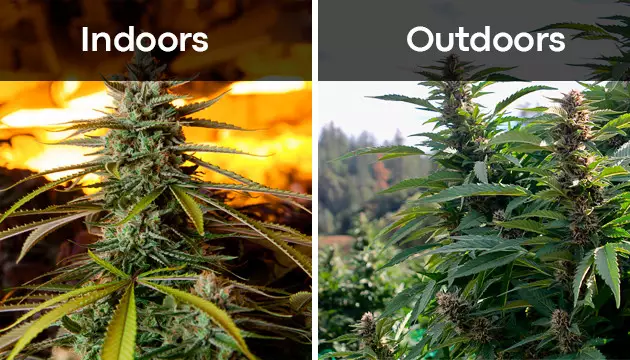
One of the first questions every grower asks themselves is whether they want to grow indoors or outdoors. There are several advantages to each technique.
When a grower cultivates indoors, they can control factors like ambient temperature and humidity more easily. With control over these kinds of variables, it’s easy for an indoor grower to significantly increase marijuana yield per plant.
In contrast, growing outdoors allows a grower to utilize the power of the sun. This can have a significant impact on a harvest’s yield. However, outdoor grows are vulnerable to factors like changes in weather, swings in temperature, precipitation and pest infestations. These can seriously impact cannabis yield in a negative way.
Growing Medium

The growing medium can also change how much weed one plant will produce. There are two main types of growing media: soil and hydroponic. Growing in soil is fairly self-explanatory – each plant grows in dirt. With hydroponics, the plants are set into a water-based growing medium. Each technique has its own factors to consider:
- Soil
- Easier – plant take root in soil, which buffers them against possible issues.
- Lower yields compared to hydroponic setups.
- Hydroponics
- Less forgiving than growing in soil – there’s no room for errors. Susceptible to issues in temperature, pH and TDS.
- Higher yields – hydroponic grows can increase yields by up to 20%.
Correct Nutrients
One of the more obvious ways to affect how much weed you can get from one plant is by using nutrients. There are three main macronutrients that every cannabis plant requires: nitrogen, phosphorus and potassium.
Nitrogen is one of the basic building blocks of all plants. It’s important in the early stages of a plant’s lifecycle and causes its stems to stretch. Potassium and phosphorus are both important to late-stage plants. These determine how many flowers your plant grows and their size, weight and density. Understanding how these nutrients affect a plant’s growth is essential for any cannabis grower.
Effective Lighting

Lighting is a crucial factor that can have huge implications on a plant’s weight. Factors like the wattage and type of light can make the exact same plants grow in vastly different ways.
Using different lights can affect a grow’s yield. For example, LEDs, one of the most popular types of lights, yield about 0.5-0,75 grams (.017-.025 ounces) per watt of power. In contrast, high-pressure sodium (HPS) lights, the industry standard for professional growers, can produce about one gram per watt. Therefore, under perfect conditions, an experienced grower can expect a 1000-watt HPS light to yield about 1000 grams (35 ounces). However, if you can’t afford a huge, expensive light, don’t worry – you don’t always need a massive HPS light to get a decent yield!
Number Of Plants
When a grower is trying to maximize their yield, more plants isn’t necessarily better. That might seem counter-intuitive at first. However, growing too many plants in a tight space can result in decreased ventilation, less light penetration through the canopy and increased humidity. In turn, these issues can lead to several problems that can decrease yields. For example, higher humidity encourages the growth of harmful pests, diseases and fungi that can cripple a grow’s yield. For this reason, growing 4 plants under a 600-watt HPS light can at times yield more weed than 16 plants under the same light.
Well-Chosen Genetics
A strain will also have a huge effect on how much weed can you get from a plant. While there are countless individual cannabis strains, there are few different over-arching categories these strains all fall into. They include:
- Photoperiodic strains – these types of plants generally grow taller and yield more but require a grower to change their total daily hours of light from 18-20 to 12 in order to make them flower. This change mirrors the natural difference between daylight hours in summer and fall.
- Autoflowers – these strains don’t require a change in light cycle. They generally grow faster than photoperiodic strains but have lower yields. They allow for more harvests in less time.
Additionally, every strain of cannabis falls into one of two main breeds: Indica and Sativa. Generally, Indica plants grow shorter and yield less than Sativas do. Sativas usually grow to be significantly taller and produce higher yields but take more time to complete their grow cycle.
Climate Control
One of the most often overlooked variables determining how much weed a plant can yield is a garden’s ventilation, ambient temperature and humidity. First, temperature and humidity can encourage a plant to grow taller and bigger. This, in turn, will have positive effect on yield. Additionally, every individual strain of cannabis has a temperature and humidity that it prefers. If a grower can dial in their garden’s conditions to best suit the strains they’re growing, they can encourage their plants to increase their yield.
Grower’s Skills
A grower’s personal skills will also play a huge part in their weed yields. A skilled grower with significant experience will be able to identify problems before they threaten their garden. Several issues, like pest infestations and nutrient deficiencies, can have a negative effect on a garden’s health and yield. This is one of the most difficult factors to affect when a grower is trying to maximize yield. The only real way for a grower to improve their skills is through time, dedication and practice.
The Most Effective Training Techniques
There are a variety of training techniques, both advanced and beginner-friendly, that can be applied to cannabis plants in order to increase the payoff and bring the total yield as close as possible to the maximum. Dedicating time to research and perform LST (Low-Stress Training) and HST (High-Stress Training) can be a grower’s most profitable investment. These methods ensure reshaping the canopy of the plant in order to achieve an even distribution of light and multiplied bud production. Several other techniques like ScrOG, SoG and defoliation can also have a hugely positive impact on a garden’s total output.
This chart compares information reported by several growers using different environments and techniques to grow the same strains. Note how different variables can affect yields.
Wet And Dry Yield. What’s The Deal?
Even after you cut down your cannabis plants, you can still affect your yield. The way a grower dries and cures their weed can be just as important as the actual growing techniques they use. When a grower dries their weed, strict climate control is required. They need to do it slowly in a room with no lights and a temperature of 18 C (64 F). If the grower has their drying and curing techniques dialed in, their dry weight will be a mere 20 to 25% of their wet weight.
Are Maximum Yields Achievable?
If a grower has their entire grow dialed in and maximized for production, they can expect their cannabis plants to produce about one gram per watt of light. To achieve this kind of precision, many growers keep a daily journal or log to measure all of the above-mentioned factors. This important task is often forgotten, but crucial in any grow. Without a journal, a grower is essentially doing guesswork, whereas a systematic approach allows the grower to achieve maximum yield, as well as being a great way to improve experience and gather long-term knowledge.
There’s no easy way to know how much bud you’ll get from one plant. All of these variables can have huge and wide-ranging effects on your plants. However, if you learn how to control factors like growing medium, nutrients, lighting, number of plants, genetics, conditions and training techniques, you can maximize your yield effectively. Moreover, by keeping a good diary and recognizing how these factors affect your total yield, you can quickly and easily learn which variables are the most important. Don’t worry – with diligent work and practice, you too can be on your way to a gram per watt in no time!
Herbies Head Shop expressly refuses to support the use, production, or supply of illegal substances. For more details read our Legal Disclaimer.

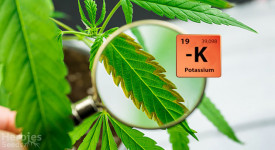
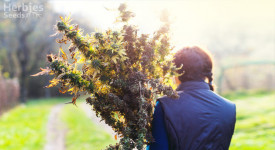



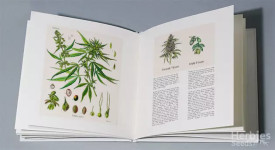


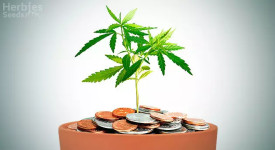

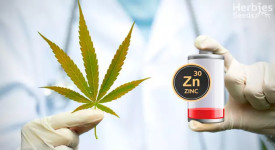

Thank you for leaving a comment for us!
Your feedback will be posted shortly after our moderator checks it.
Please note that we don’t publish reviews that: